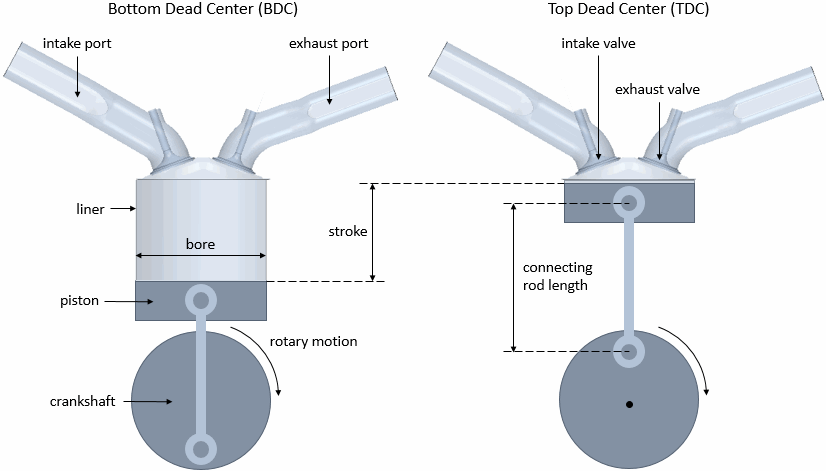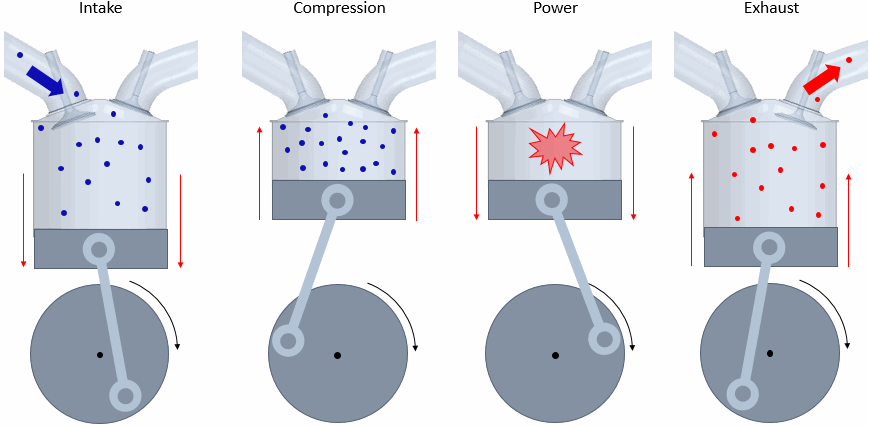ICE Mechanism
The development and improvement of internal combustion engines comes from a systematic analysis of the in-cylinder flow. Simcenter STAR-CCM+ In-cylinder is capable of simulating the in-cylinder flow of reciprocating internal combustion engines that operate on a four-stroke or a two-stroke cycle at steady speed.
In a reciprocating internal combustion engine, pistons move up and down to transform the expansion of gases due to combustion into rotational motion. A crank mechanism transmits the linear motion of the pistons through a connecting rod to the rotating shaft. The position at which the piston is at its lowest point is called Bottom Dead Center (BDC). When the piston is at its highest point, it is at Top Dead Center (TDC).
The following image displays a schematic diagram of a reciprocating four-stroke engine:

The bore represents the diameter of the engine cylinder; the engine stroke specifies the distance that the piston travels from BDC to TDC.
Four-Stroke Engine
A four-stroke engine is an engine where the piston goes through four strokes while turning the crankshaft twice. Intake valves regulate the inflow of air-fuel mixture through the intake port; exhaust valves similarly regulate the outflow of burned gases through the exhaust port.
The following image displays the power cycle of a four-stroke engine:

- Intake
- During the intake stroke, the piston moves from TDC to BDC drawing an air-fuel mixture through the intake port into the cylinder. The intake valves are in their open positions.
- Compression
- In the compression stroke, the piston returns from BDC to TDC compressing the air-fuel mixture. The intake and exhaust valves are closed. At the end of the compression stroke, the crankshaft has completed a complete 360 degree revolution.
- Power
- The power stroke starts with the ignition of the air-fuel mixture. The expansion of the mixture pushes the piston from TDC to BDC, which forces the crank to rotate. The intake and exhaust valves are closed.
- Exhaust
- During the Exhaust stroke, the piston returns from BDC to TDC. The exhaust valves are open to release the burned gases through the exhaust port.
At the end of a four-stroke cycle, the crankshaft has completed two complete revolutions (720 degree).
Two-Stroke Engine
Two-stroke engines complete the power cycle with two strokes of the piston while turning the crankshaft only once (360 degree).
- Compression
- In the compression stroke, the piston moves from BDC to TDC compressing the air-fuel mixture.
- Power
- In the power stroke, the air-fuel mixture ignites and starts the combustion process. The expansion of the mixture pushes the piston from TDC to BDC.
Between the end of the power stroke and the beginning of the next compression stroke, a fresh air/fuel charge enters through the intake port and pushes the exhaust gases out through the exhaust port.
Depending on this process of admitting air and expelling exhaust gas—the scavenging process—, two-stroke engines can be categorized as follows:

- Uniflow
- For uniflow engines, the fresh air/fuel mixture and the burned gases flow in the same direction. The fresh charge enters through the intake ports at the bottom of the cylinder, flows upwards, and pushes the burned gases out through the valve-controlled exhaust port at the top.
- Loop Flow
- For loop flow engines, the intake port and the exhaust port are located on the same side of the cylinder. The incoming charge passes over the piston, flows upwards and forms a loop within the cylinder, expelling the burned gases through the exhaust port.
- Cross Flow
- Cross flow engines have the intake port and the exhaust port on opposite sides of the cylinder. A deflector on top of the piston directs the incoming charge upwards, pushing the exhaust gas down and out the exhaust port.
Except for the exhaust port in a uniflow scavenging design, the opening and closing of the ports in a two-stroke engine are piston-controlled. To model this process, Simcenter STAR-CCM+ In-cylinder represents the ports with separate plenums and uses sliding interfaces between the combustion chamber and the plenums.